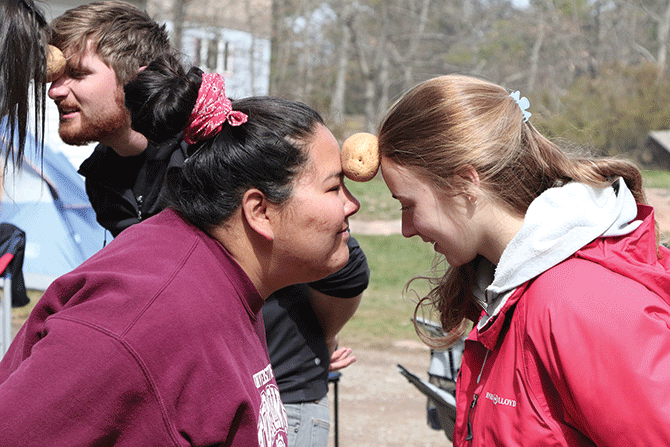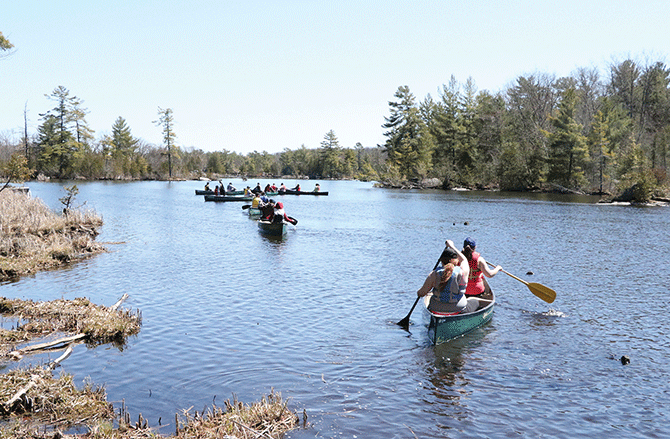Land as Teacher
Using learnings from the land and Indigenous people to shape tomorrow’s teachers
How a 12-day placement in a local Indigenous community gives teacher candidates a chance “to develop the knowledge, motivation, and skills to facilitate the transmission of an environmental consciousness to their future students… and to establish inclusive learning spaces by being better able to teach to and about Indigenous people.”
My dad taught me about the land. We were a hunting, gathering, and fishing family, so we were always on the land harvesting food. I have many wonderful memories: fishing; snaring rabbit; partridge hunting; and picking apples, berries, fiddleheads, chokecherries, puff balls, leeks and mushrooms.
Picking mushrooms requires particular knowledge and skill because some mushrooms are dangerous. After a day picking mushrooms my dad would fry them with onions and serve them with venison steaks or chops.
Invariably at the dinner table, my brother, sister, or I would ask our Dad, “How do we know these aren’t the poison ones?” to which he would reply, “Well, if you wake up in the morning, then I know they weren’t poisonous.” While his response provided a small degree of worry, my siblings and I found it funny because we had trust in his knowledge. I acknowledge that my love of the land definitely comes from my father.
Filling a gap
When a gap needs to be filled, you fill it. This is a common experience for me as an Indigenous educator (Anishinaabe – Bear Clan from Kitigan Zibi First Nation) trying to fill the gap in Indigenous education.
I teach in the School of Education at Trent University and have had numerous Bachelor of Education students approach me inquiring about including Indigenous knowledge into their curriculum plans. They came knocking on my office door with requests such as, “My associate teacher is asking me to teach the Grade 6 unit on First Nations Peoples and European Explorers in my practicum, and I have no idea where to start,” or “My practicum is in a secondary school English class, what Indigenous texts could I explore with my students?”
These teacher candidates identified a gap in their knowledge and skill regarding inclusionary practice, yet had the desire and fortitude to ensure their teaching would be inclusive of Indigenous students and promote healthy cross-cultural sharing.
If your organization, school district or faculty of education is an EdCan member (see the list here), you can enjoy unlimited access to our online content! Click here to create your online account.
I had enough of these requests to identify a need for an explicit learning opportunity toward the goal of educating teacher candidates about Indigenous people and how to teach Indigenous students and non-Indigenous students about Indigenous people. Since all teacher candidates in the School of Education at Trent University are required to find a site for an alternative learning opportunity for three weeks or 75 hours, I felt this would be an opportune timeframe for an in-depth learning opportunity.
Land-based learning
Since the worldview of Indigenous peoples is connected to the environment, and since there is a global/universal need for all students to learn about the state of the planet, I felt a land-based program would serve the dual purpose of learning about Indigenous people while instilling an ecological consciousness in teacher candidates, and ultimately their future students. I also knew that I could take my students the furthest in the shortest amount of time teaching on, and with, the land. The Learning From the Land and Indigenous People alternative settings placement was born in 2007 and has been delivered every spring since then.

Teacher candidates spend twelve days with me in my home community of Burleigh Falls and Lovesick Lake in the Kawartha Lakes to experience land-based activities in order to develop a personal connection to the environment and an awareness of Indigenous, specifically Anishinaabe, culture.
The placement offers teacher candidates a chance to develop the knowledge, motivation, and skills to facilitate the transmission of an environmental consciousness to their future students. Additionally, the placement assists teacher candidates in establishing inclusive learning spaces by being better able to teach to and about Indigenous people. It is my hope that teacher candidates develop themselves personally and professionally while increasing their cultural capacity to teach Indigenous and environmental education.

Learning activities on the placement include: a medicine walk, fishing, tracking/bush work, harvesting, canoeing, shelter building, a “solo” (period spent sitting alone in nature), observation and survival skills, a daily morning circle, sharing circles, traditional teachings, traditional land-based practices, storytelling, eating collectively, field trips to local Indigenous sites, drumming and dancing, and environmental learning activities that are transferable to the classroom.
Making learning connections
“These future teachers clearly state that they are better prepared to teach about Indigenous people and teach Indigenous children.”
Through an intensive evaluation process, including daily student reflections and a pre/post-evaluation questionnaire, teacher candidates indicate that the Learning From the Land and Indigenous People placement is immensely enjoyed and valued as a learning experience. Many define the placement as the highlight of their teacher education program: “This was the best part of my year.” Another teacher candidate says: “Truly this has been one of the most meaningful experiences of my life. I really feel changed and in such a positive way.”
Teacher candidates identify connections that were made on multiple levels:
- within themselves – “I feel so much more whole. I feel at peace and much more centred and calm. Obviously the more whole the teacher is the better able they are to teach their students.”
- with the land/environment – “The image of Earth as mother has further deepened my respect and love for the Earth.”
- within the teaching and learning group – “This placement has allowed me to make new relationships that I will be able to draw on and maintain for a long time to come.”
- with their teaching practice – “The teachings will carry me far beyond character development initiatives – this is curriculum in action. The depth of community, the acceptance of learning, the affirmation of no shame, are principles which need to carry us all as teachers.”
- with the Indigenous culture – “Before this placement I didn’t realize how incredibly deep and rich Indigenous culture is.”
These future teachers clearly state that they are better prepared to teach about Indigenous people and teach Indigenous children – “I now have new skills so that I can teach about Anishinaabe and First Nations peoples to my classes in a respectful and engaging way. I feel that I am also better prepared to teach Indigenous students.” Perhaps the experience can be summed up by this teacher candidate: “I came away with a better understanding of Anishinaabe culture as well as a new yet familiar approach to teaching and learning. This was a rich experience – a lot was accomplished in a short time. I feel full of possibility with respect to future teaching. I also feel connected with local Anishinaabe culture and the land.”
Holistic learning on and with the land
The Learning From the Land and Indigenous People alternative settings placement is transformational and self-actualizing education that occurs through teaching holistically by engaging all four aspects of who students are as human beings. That means teaching to students’ mental, physical, emotional, and spiritual capacities.
“An opportunity to learn about Indigenous people through the land and to move through the 4Rs: respect, relationship, reciprocity, responsibility.”
All education, including environmental sustainability education, must engage all four parts of our beings: our minds, our bodies, our hearts, and our spirits. While it may seem easy to envision how we could engage the mind, the heart, and the body, it is somewhat more difficult to envision how we could engage the spirit or the soul. Talking about spirituality in education can cause tension because some equate it with religion. From an Indigenous perspective, spirituality has nothing to do with religion. Spirituality is about knowing, feeling, and acting like we are connected to the natural world. It is a spirit-to-spirit connection and it is accessible to everyone regardless of religion because we all share this same natural world, this one planet. It is not about religion; it is recognizing that we only exist because of the life-givers that provide us with everything that we need. The life-givers are the air that we breathe, the water that we drink, the sun that provides light and heat, and the earth that provides us with the food that we eat. We all need those things, and that is universal.
Spirituality is also about being humble enough to acknowledge that humans are the most insignificant beings on this planet, because we cannot live without the life-givers that are provided for us – yet the life-givers can exist without us, and perhaps the planet might be all the better. The earth does not need us, but we need the earth. This humility allows us to understand and respect our connection to, and dependence on, everything else.
In the Learning From the Land and Indigenous People alternative settings placement, teacher candidates have the opportunity to learn about Indigenous people through the land and to move through the 4Rs: respect, relationship, reciprocity, responsibility.
Respecting the land requires re-spect, looking again, at all that the natural world provides; seeing ourselves as inextricably linked, and thus in relationship, with the natural world; engaging with the natural world in reciprocal and balanced ways; and acting with responsibility, or response-ability, to ensure respect, relationship, and reciprocity.
To live life in a spiritual way is to live respectfully in reciprocal relationships that result in taking responsibility.
The Learning From the Land and Indigenous People alternative settings placement engages this spirituality with teacher candidates, with the hope that they will teach to their students’ spirits, resulting in spiritual connections to creation and the natural world.
I encourage all educators to consider how they can instil and foster a spiritual connection in environmental education through land-based learning.
This will shape the future.
Photo: Rich McPherson
First published in Education Canada, March 2020
